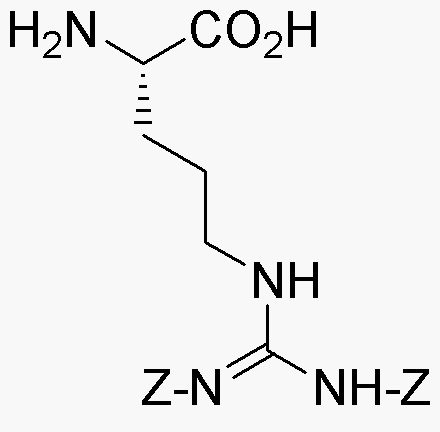Nw,Nw'-Di-Z-L-arginine is widely utilized in research focused on:
- Biochemical Research: This compound serves as a valuable tool in studying nitric oxide synthase activity, which is crucial for understanding cardiovascular health and related diseases.
- Drug Development: It is often used in the formulation of peptide-based drugs, enhancing their efficacy and stability in therapeutic applications.
- Cell Culture Studies: Researchers use it to optimize growth conditions for various cell types, particularly in studies involving immune responses and cancer research.
- Gene Delivery Systems: The compound is effective in enhancing the delivery of genetic material into cells, making it a key player in gene therapy and vaccine development.
- Protein Interaction Studies: It aids in the investigation of protein-protein interactions, which is essential for understanding cellular functions and developing targeted therapies.
Informations générales
Propriétés
Sécurité et réglementation
Applications
Nw,Nw'-Di-Z-L-arginine is widely utilized in research focused on:
- Biochemical Research: This compound serves as a valuable tool in studying nitric oxide synthase activity, which is crucial for understanding cardiovascular health and related diseases.
- Drug Development: It is often used in the formulation of peptide-based drugs, enhancing their efficacy and stability in therapeutic applications.
- Cell Culture Studies: Researchers use it to optimize growth conditions for various cell types, particularly in studies involving immune responses and cancer research.
- Gene Delivery Systems: The compound is effective in enhancing the delivery of genetic material into cells, making it a key player in gene therapy and vaccine development.
- Protein Interaction Studies: It aids in the investigation of protein-protein interactions, which is essential for understanding cellular functions and developing targeted therapies.
Documents
Fiches de données de sécurité (FDS)
La FDS fournit des informations de sécurité complètes sur la manipulation, le stockage et l’élimination du produit.
Spécifications du produit (PS)
Le PS fournit une description complète des propriétés du produit, notamment sa composition chimique, son état physique, sa pureté et les exigences de stockage. Il détaille également les plages de qualité acceptables et les applications prévues du produit.
Certificats d'analyse (COA)
Recherchez des certificats d'analyse (COA) en saisissant le numéro de lot du produit. Les numéros de lot et de lot se trouvent sur l'étiquette d'un produit, après les mots « Lot » ou « Lot de fabrication ».
Numéro de catalogue
Numéro de lot/série
Certificats d'origine (COO)
Ce certificat d'exploitation confirme le pays dans lequel le produit a été fabriqué, et détaille également les matériaux et composants utilisés et s'il est issu de sources naturelles, synthétiques ou autres sources spécifiques. Ce certificat peut être requis pour les douanes, le commerce et la conformité réglementaire.
Numéro de catalogue
Numéro de lot/série
Fiches de données de sécurité (FDS)
La FDS fournit des informations de sécurité complètes sur la manipulation, le stockage et l’élimination du produit.
DownloadSpécifications du produit (PS)
Le PS fournit une description complète des propriétés du produit, notamment sa composition chimique, son état physique, sa pureté et les exigences de stockage. Il détaille également les plages de qualité acceptables et les applications prévues du produit.
DownloadCertificats d'analyse (COA)
Recherchez des certificats d'analyse (COA) en saisissant le numéro de lot du produit. Les numéros de lot et de lot se trouvent sur l'étiquette d'un produit, après les mots « Lot » ou « Lot de fabrication ».
Numéro de catalogue
Numéro de lot/série
Certificats d'origine (COO)
Ce certificat d'exploitation confirme le pays dans lequel le produit a été fabriqué, et détaille également les matériaux et composants utilisés et s'il est issu de sources naturelles, synthétiques ou autres sources spécifiques. Ce certificat peut être requis pour les douanes, le commerce et la conformité réglementaire.


